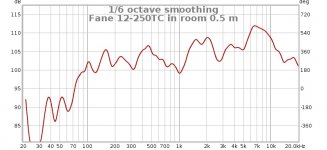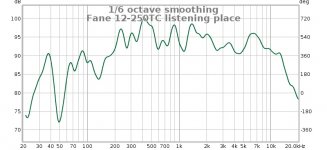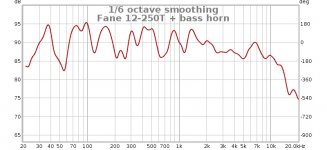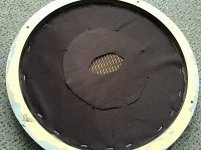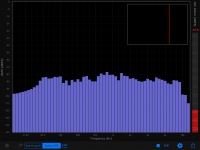...There are many cone midranges and tweeters with closed back, like a regular steel basket but with no openings, so my puny example here may be even not as bad as these.
That there are, but there is also a fundamental difference, viz. that they were designed to be closed back units in the first place, with motor and suspension, and as relevant cone & basket profiling designed for that purpose.
Without other means of EQ? I don't know the 12" Fane, only the 15". It is bright and blowtorchy unfiltered, but perfectly fine with selective and precise EQ.
No. Not my units, and Steve (their owner ) is perfectly happy with them as is, without any EQ. I imagine the response could be rebalanced sufficiently with appropriate EQ to the point where I'd be happy enough on that score, but line arrays aside, I'm not very interested in applying heavy EQ to wideband drive units. Purely as a personal approach, when it gets to that point I would rather use a different drive unit or shift to a multiway.
Ok so I did a fast drawing in sketchup
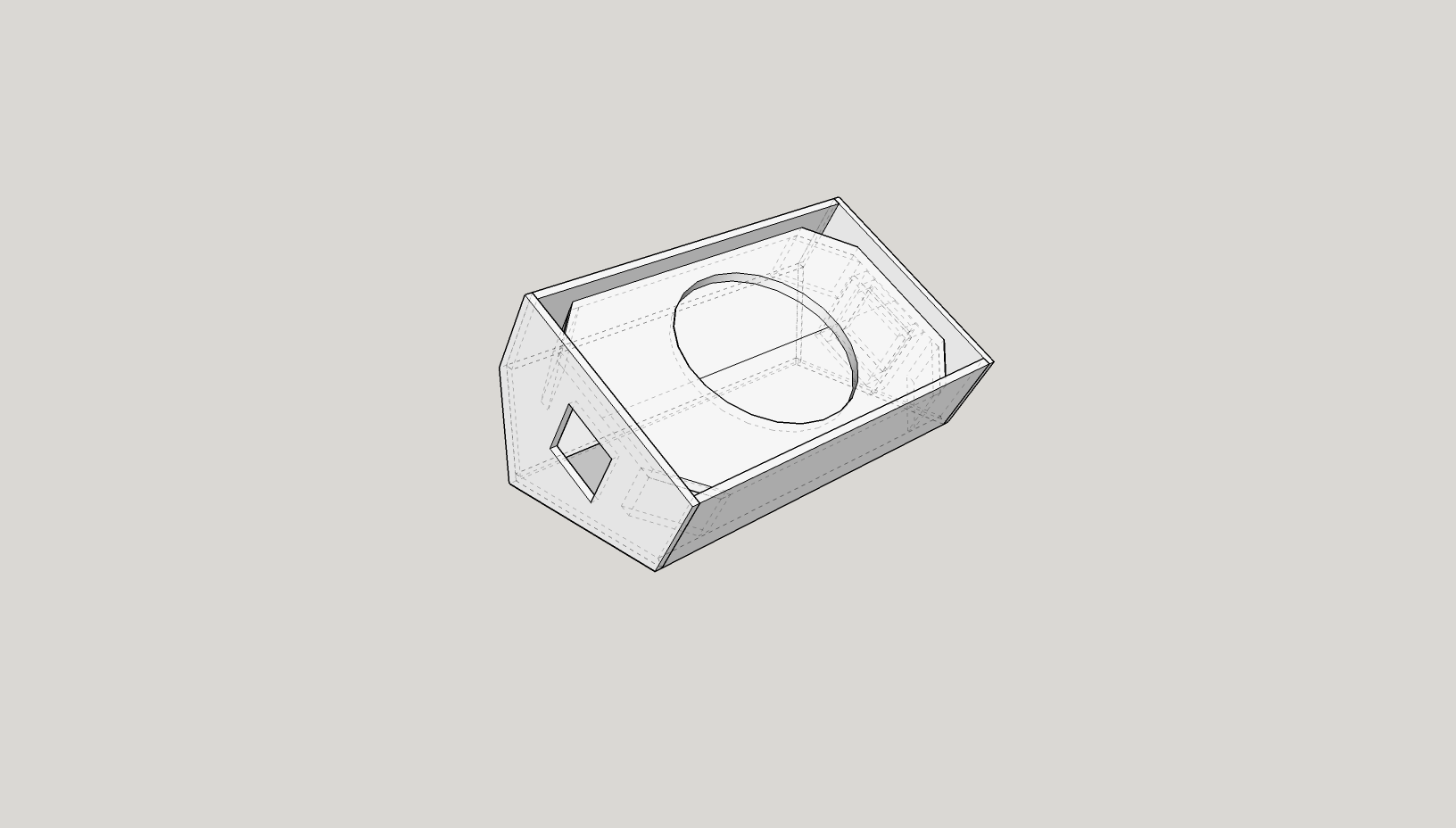
I would like to use 12mm birch only the baffle is 18mm
So it's not much but it's not an extremely big box.
It is mainly for getting the weight down and make it easy transportable.
The bas reflex ports also serve use as bracing. Maybe I will add some interna bracing but it's not a giant subwoofer either so.....
One side will have a handle the other side will have a pole mount.
I tuned it a little lower so the highpass can go a little lower without much extra excursion.
It will do around 110db @ 52Hz using 200w of power. From 87Hz and above it will do 118db using 200w.
It can do more then this but it will start to go over Xmax. Don't know what Xdamage is for this speaker.

I would like to use 12mm birch only the baffle is 18mm
So it's not much but it's not an extremely big box.
It is mainly for getting the weight down and make it easy transportable.
The bas reflex ports also serve use as bracing. Maybe I will add some interna bracing but it's not a giant subwoofer either so.....
One side will have a handle the other side will have a pole mount.
I tuned it a little lower so the highpass can go a little lower without much extra excursion.
It will do around 110db @ 52Hz using 200w of power. From 87Hz and above it will do 118db using 200w.
It can do more then this but it will start to go over Xmax. Don't know what Xdamage is for this speaker.
Purely as a personal approach, when it gets to that point I would rather use a different drive unit or shift to a multiway.
Interesting. It was the multi way path that eventually led me to accept DSP and then further down another road until i met the FC152.
I differentiate between "point source" and what I consider to be "fractioned" speakers, if the implementation is good then it does not matter so much how many drivers there are as long as it's point source from 2-300hz up.
Hate it when I hear some supposedly good commercial design, and you clearly hear the separation between drivers. Spreading out in height and space the sound of instruments based on frequency is just horrible.
I believe it may be possible to "tame" the big fane tri-cone drivers suitably well with simple passive solution and various other bits.
But a simple solution needs a lot of care and attention to detail to perfect, it is easy to add to a solution, much harder to subtract.
So for the foreseeable future, using DSP = the lesser evil IMO
I rest my case. Different strokes for different folks.  Alas, some will never accept that; fortunately most people here don't suffer from that sort of delusion.
Alas, some will never accept that; fortunately most people here don't suffer from that sort of delusion. 
As an aside, I don't find any particular problem integrating drivers in multiways myself -or rather, that's [one of] the challenge, to do so well. In an ideal world, wherever you cross you'd want to keep the emitting centres within 1/2 (or preferably 1/3) wavelength; in my experience 1 wavelength is fine < c. 300Hz and acceptable in certain regions higher up where our ability to percieve spacial cues is poor. Depends also on the relative polar properties of the drive units and the listening distance. YMMV.
As an aside, I don't find any particular problem integrating drivers in multiways myself -or rather, that's [one of] the challenge
Last edited:
I believe it may be possible to "tame" the big fane tri-cone drivers suitably well with simple passive solution and various other bits.
But a simple solution needs a lot of care and attention to detail to perfect, it is easy to add to a solution, much harder to subtract.
So for the foreseeable future, using DSP = the lesser evil IMO
With the 15", I have had success with just three parametric bands, one was used to remove room-related boom. So really just two. There are no 20+ dB spikes, so when you smooth out the general trend, the resulting response is within reasonable limits. An analog/passive filter is probably very feasible.
I am not against passive at all, but my systems are all digital anyway and have either DSP built-in or have a capable CPU and interface to do DSP in software. Also, I do bang-for-buck systems, and it's super hard to beat two Fane tricoil fullrange drivers, some cheap woodboard and a discounted AV receiver. Or the drivers, wood, and a raspberry pi with hifiberry amp2 and software dsp.
Ivo, I was quite happy using only a single shelf of EQ on the 15".
But when you have more processing power, I think it's better to use what you have to get an even better result.
Agree on the DSP thing, audio processing is so cheap these days, no need for high cost components.
But when you have more processing power, I think it's better to use what you have to get an even better result.
Agree on the DSP thing, audio processing is so cheap these days, no need for high cost components.
Hi guys,
This weekend I have build a small monitor cab around 50L and ported like simulated a few posts back.
So the first measurement outside gave this:
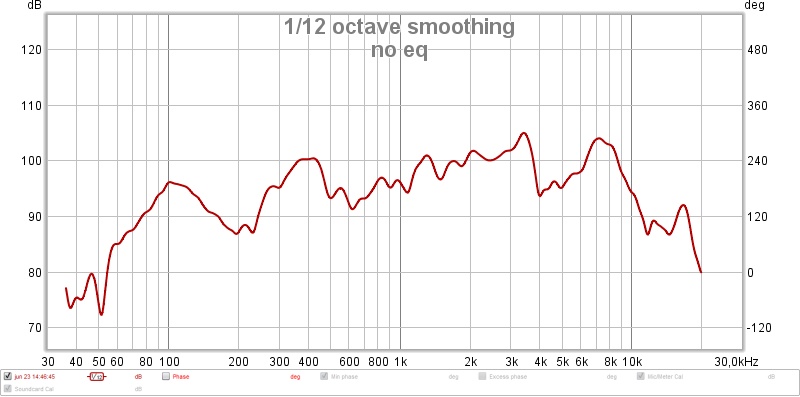
So the bump around 100Hz was simulated.
Another thing that got to me is the fact that there is no baffle step compensation.
So calculating this should be around 200-300Hz.
If you look at it and leave the bump out this is noticable.
So I applied a shelving filter around 200-300Hz
And then I put a parametric EQ to even out the 100Hz peak.
The result is the following measurement.
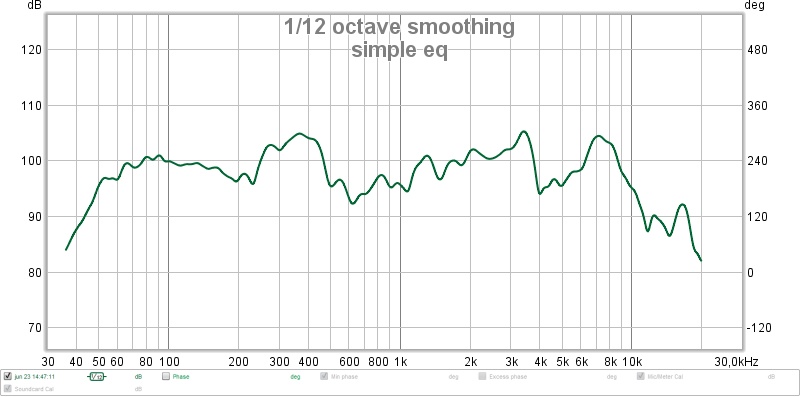
I did add a high pass around 50Hz.
The result is not bad I would say.
The microphone I used was calibrated so the decibel level is correct. But the position of the microphone was more like 2Meters and I didn't measure the power that was send to the speaker.
This weekend I have build a small monitor cab around 50L and ported like simulated a few posts back.
So the first measurement outside gave this:

So the bump around 100Hz was simulated.
Another thing that got to me is the fact that there is no baffle step compensation.
So calculating this should be around 200-300Hz.
If you look at it and leave the bump out this is noticable.
So I applied a shelving filter around 200-300Hz
And then I put a parametric EQ to even out the 100Hz peak.
The result is the following measurement.

I did add a high pass around 50Hz.
The result is not bad I would say.
The microphone I used was calibrated so the decibel level is correct. But the position of the microphone was more like 2Meters and I didn't measure the power that was send to the speaker.
I put my pair into boxes made for some other 12" speaker, ca 42 l and 7 cm dia x 8 cm length port. First quick listen at low volume is promising. These definitely deserve a proper and nicely finished cabinet. I do not regret buying these instead of the 15" version. I am looking forward to trying out with my horn subs and compare to the current three way horn system.
Here are some measurements in my room. 0.5 m distance and listening distance (around 2.5 m and 30 deg off axis). The boxes are placed in a way that the center is at ear height. Both 1/6 octave smoothed. I think this is really not bad. There is a 10 mm diameter hole in the side of the boxes (was meant for a stand) and the second 6.3 mm jack in the back is also open, so it is not too air tight.
These would be a great pair of party loudspeakers, and a small sub can be added if needed. I may play around with the EQ, but in the room I have, this sounds pretty good as it is.
These would be a great pair of party loudspeakers, and a small sub can be added if needed. I may play around with the EQ, but in the room I have, this sounds pretty good as it is.
Attachments
Member
Joined 2009
Paid Member
30 deg off axis
this is the key to avoiding the hot treble - but I guess there are consequences such as restricted listening position, need to avoid small reflective room ?
Yes, this room is a cellar workshop, the speakers are on the short side 2.5 m apart, the ceiling is only something like 2.1 m low, concrete floor and not too much furniture. I actually plan to refurbish it and apply some acoustic treatment later.
In the attachment, there is measurement of the left side using my bass horns, crossed over at 120 Hz and time aligned. I intentionally left the response sloped not to have too much treble. Now I only need to build some smaller subs to make this into garden party speaker system. After the speakers will be burned in, I will try to do some outdoor measurements.
In the attachment, there is measurement of the left side using my bass horns, crossed over at 120 Hz and time aligned. I intentionally left the response sloped not to have too much treble. Now I only need to build some smaller subs to make this into garden party speaker system. After the speakers will be burned in, I will try to do some outdoor measurements.
Attachments
I ordered a pair from solen yesterday. They didn’t have them in stock even though their website mentioned two in stock, but I had a very interesting talk with the speaker tech there. He offered to do some simulations for me and he sent me the results today. He recommended a ported box with a max volume of 4 cubic feet, with two 4" by 4" vents, resulting in an f3 of 40.59hz. I want to get the most low end that I can from these drivers, and the ported box seemed to be the way to go while keeping the build simple. Size isn’t an issue since they will sit in a dedicated large size room.
Ported enclosures for the 12-250tc don’t seem to get much attention, at least on this forum, and I couldn’t find any examples on the internet. Do you guys have any experiences with that speaker in a ported box ? And is there any reason why people seem to avoid this kind of enclosure with this particular speaker ?
I trust the recommendations I’ve been given at solen, an most likely will be following them when building my enclosures, but it’s alway nice to have different opinions before making choices.
Ported enclosures for the 12-250tc don’t seem to get much attention, at least on this forum, and I couldn’t find any examples on the internet. Do you guys have any experiences with that speaker in a ported box ? And is there any reason why people seem to avoid this kind of enclosure with this particular speaker ?
I trust the recommendations I’ve been given at solen, an most likely will be following them when building my enclosures, but it’s alway nice to have different opinions before making choices.
Maybe bigger than most want ?
driver :
Vas = 78 lts
fs = 50 Hz
Qts = 0.64
D = 11 in
Box Dimensions
Vb = 6.49 ft3 = 183.71 lts
f3 = 31.62 Hz
fb = 31.62 Hz
Dv = 4 in = 10 cm
Lv = 2.25 in = 5.43 cm
Vb: Speaker Box Internal Volume
f3: 3dB Cutoff Frequency
fb: Enclosure Resonant Frequency
Dv: Port Diameter
Lv: Port Length
Note: Port volume (inside the port) does not count toward speaker volume.
driver :
Vas = 78 lts
fs = 50 Hz
Qts = 0.64
D = 11 in
Box Dimensions
Vb = 6.49 ft3 = 183.71 lts
f3 = 31.62 Hz
fb = 31.62 Hz
Dv = 4 in = 10 cm
Lv = 2.25 in = 5.43 cm
Vb: Speaker Box Internal Volume
f3: 3dB Cutoff Frequency
fb: Enclosure Resonant Frequency
Dv: Port Diameter
Lv: Port Length
Note: Port volume (inside the port) does not count toward speaker volume.
Dinolobe, I made a ported enclosure for the 12-250TC, it works just fine, slightly smaller than your 4cu ft. The reason I do not see the point of making a huge enclosure for this driver, is that if/when you decide to push it really hard, you'll have rising distortion in the bass region just before the high frequencies start running into trouble.
The 12-250TC can do bass for sure, but not ridiculous amounts of it.
Much better than you can get with any 8" or smaller though.
Here's a distortion plot just as its limits measured just over 1.5m distance from speaker,ca 5 degrees off axis, half space, some small eq with a regular minidsp.
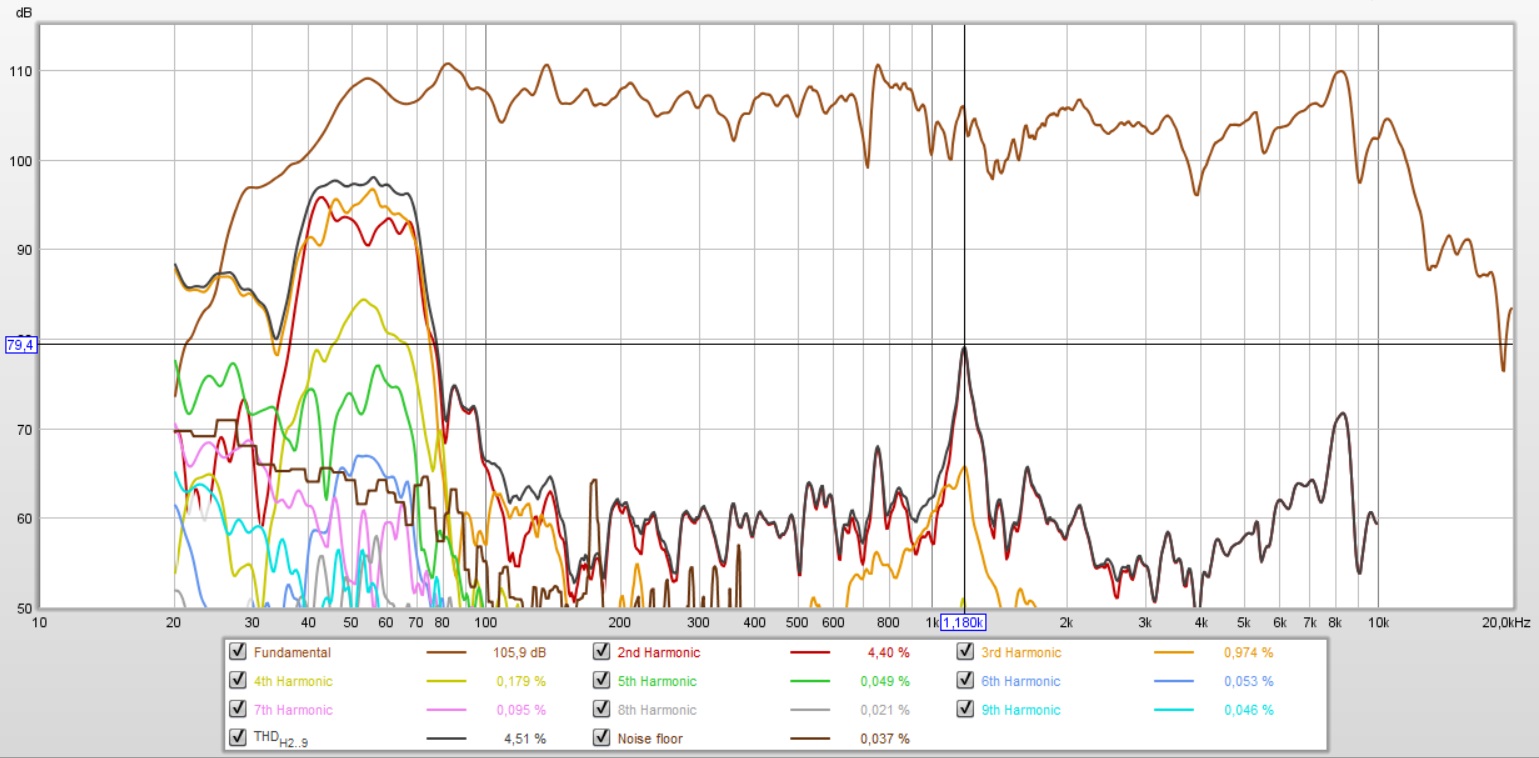
Box sim and stuff here:
Fane 12-250TC vs FC152 (15-300TC)
The 12-250TC can do bass for sure, but not ridiculous amounts of it.
Much better than you can get with any 8" or smaller though.
Here's a distortion plot just as its limits measured just over 1.5m distance from speaker,ca 5 degrees off axis, half space, some small eq with a regular minidsp.
Box sim and stuff here:
Fane 12-250TC vs FC152 (15-300TC)
Decided to do something about the hot treble from this otherwise excellent driver. This has been mooted on here before but I can’t remember who suggested it.
My sealed box Fanes have a circular grille comprising a Fender Tweed guitar amp grille cloth. This is better than nothing, but I figured there was still a lot of room for improvement.
I installed a couple of secondary grilles behind the Fender element. One covers the whole rear of the Fender cloth and has a vertical, elliptical slit cut into the centre. This slit resembles the pupil of a cat’s eye and allows the treble from the central whizzer to pass.
A further, smaller circular grille is placed to attenuate the larger whizzer, relative to the main cone, and has a slightly smaller cat’s eye slit than the one in the preceding grille.
The result of these three grilles, is to tilt the rising response to a flatter profile and the listening results are great. The sound is better balanced top to bottom and sounds natural and unforced at both high and low levels.
Attached is a pic of the grille arrangement, plus a 6th octave pink noise, in-room spectrum taken at 1.5m and 10deg off-axis.
The spectrum shows the flattened response and the bass performance of the 80L sealed cab, hard-up against the rear wall of my room.
Not a bad result from a couple of bits of cloth, some staples and a needle & thread.
My sealed box Fanes have a circular grille comprising a Fender Tweed guitar amp grille cloth. This is better than nothing, but I figured there was still a lot of room for improvement.
I installed a couple of secondary grilles behind the Fender element. One covers the whole rear of the Fender cloth and has a vertical, elliptical slit cut into the centre. This slit resembles the pupil of a cat’s eye and allows the treble from the central whizzer to pass.
A further, smaller circular grille is placed to attenuate the larger whizzer, relative to the main cone, and has a slightly smaller cat’s eye slit than the one in the preceding grille.
The result of these three grilles, is to tilt the rising response to a flatter profile and the listening results are great. The sound is better balanced top to bottom and sounds natural and unforced at both high and low levels.
Attached is a pic of the grille arrangement, plus a 6th octave pink noise, in-room spectrum taken at 1.5m and 10deg off-axis.
The spectrum shows the flattened response and the bass performance of the 80L sealed cab, hard-up against the rear wall of my room.
Not a bad result from a couple of bits of cloth, some staples and a needle & thread.
Attachments
Last edited:
250TC seemed to be a Karlson friendly driver - there was no boom (nor bass) with it mounted in a little K12 with slit port damped (~36 liter back chamber) - I should had measured it while in the Karlsonator12 (fb ~37Hz) as was able to play hip-hop reasonably well. Despite high-ish Q, it might play well in K15. K15 with proper driver is one of the best vintage enclosures, and often a better compromise than folded horn.
Decided to do something about the hot treble from this otherwise excellent driver. This has been mooted on here before but I can’t remember who suggested it.
My sealed box Fanes have a circular grille comprising a Fender Tweed guitar amp grille cloth. This is better than nothing, but I figured there was still a lot of room for improvement.
I installed a couple of secondary grilles behind the Fender element. One covers the whole rear of the Fender cloth and has a vertical, elliptical slit cut into the centre. This slit resembles the pupil of a cat’s eye and allows the treble from the central whizzer to pass.
A further, smaller circular grille is placed to attenuate the larger whizzer, relative to the main cone, and has a slightly smaller cat’s eye slit than the one in the preceding grille.
The result of these three grilles, is to tilt the rising response to a flatter profile and the listening results are great. The sound is better balanced top to bottom and sounds natural and unforced at both high and low levels.
Attached is a pic of the grille arrangement, plus a 6th octave pink noise, in-room spectrum taken at 1.5m and 10deg off-axis.
The spectrum shows the flattened response and the bass performance of the 80L sealed cab, hard-up against the rear wall of my room.
Not a bad result from a couple of bits of cloth, some staples and a needle & thread.
A simple wide notch filter can do the trick also, but i heared it also that the treble can be tamed with fender speakercloth. But that notch filter (basicly and resistor, and inductor and a cap, all of small size and value) can make a wide cut in the offending frequencies of about 10dB. I did model it on a theoretic driver (just to study the system) and it would cost my 50€ to get the parts of good quality to make those filters for 2 speakers. But that was not with a measured response (as i don't have the speakers yet, it's a project for next winter for me). To really get it right, measure your speakers and use a tool like the freeware xsim to calculate the right filter setup.
And yes, you may loose a db (or maybe 2) in efficiency with this filter, but those speakes are already very efficient that it won't matter much.
Well, since that efficiency is what you're trying to cut in the first place since it's useless excess resonance, you're in effect left with the real sensitivity.  So I wouldn't worry too much about that in & of itself. Depends on circumstance; if you're killing a narrow or even a broad[ish] band resonance you're OK so long as it's done well. I actually think people can run into more trouble when rebalancing a general rising response trend, even if it might appear on the face of it to be more straightforward; applying the same criteria and target curves as are often used with multiway systems don't necessarily work all that well with a single driver setup given their dispersion behaviour.
So I wouldn't worry too much about that in & of itself. Depends on circumstance; if you're killing a narrow or even a broad[ish] band resonance you're OK so long as it's done well. I actually think people can run into more trouble when rebalancing a general rising response trend, even if it might appear on the face of it to be more straightforward; applying the same criteria and target curves as are often used with multiway systems don't necessarily work all that well with a single driver setup given their dispersion behaviour.
Progressive thicknesses of grillcloth have been used as Steve has since the '30s to adjust FR, whether forward or rear radiation. Plenty of variations on the theme also e.g. Avalon. I did so with the commercial Viotti Ones and Viotti Towers for MA-Sota, which were designed to be used with the grills in place. Earl Geddes's stuffed waveguides are another variation on the theme, albeit with slightly different objectives. And so on.
Progressive thicknesses of grillcloth have been used as Steve has since the '30s to adjust FR, whether forward or rear radiation. Plenty of variations on the theme also e.g. Avalon. I did so with the commercial Viotti Ones and Viotti Towers for MA-Sota, which were designed to be used with the grills in place. Earl Geddes's stuffed waveguides are another variation on the theme, albeit with slightly different objectives. And so on.
Last edited:
- Home
- Loudspeakers
- Full Range
- New 12" Full-Range: Fane 12-250TC
